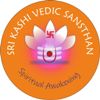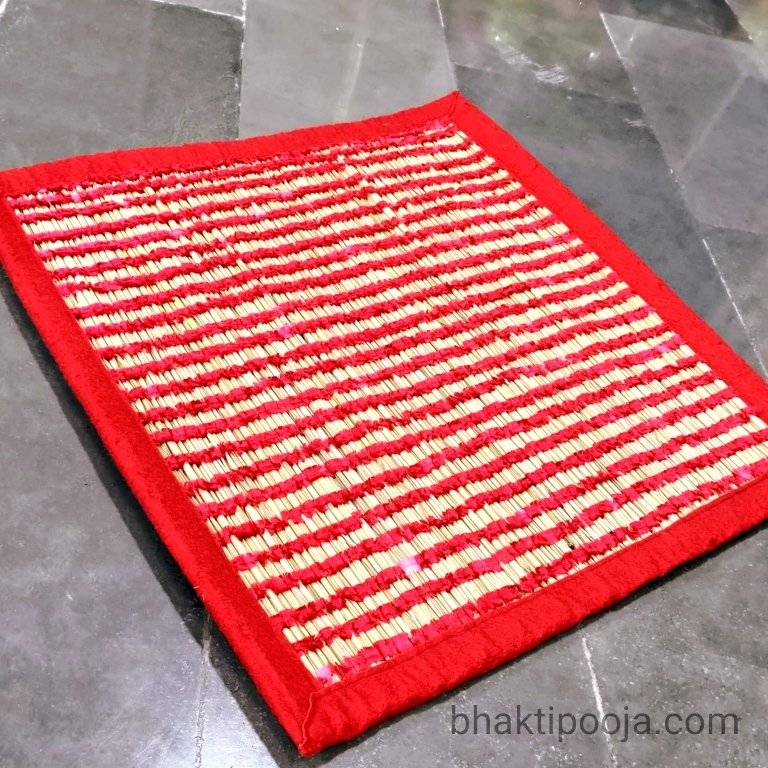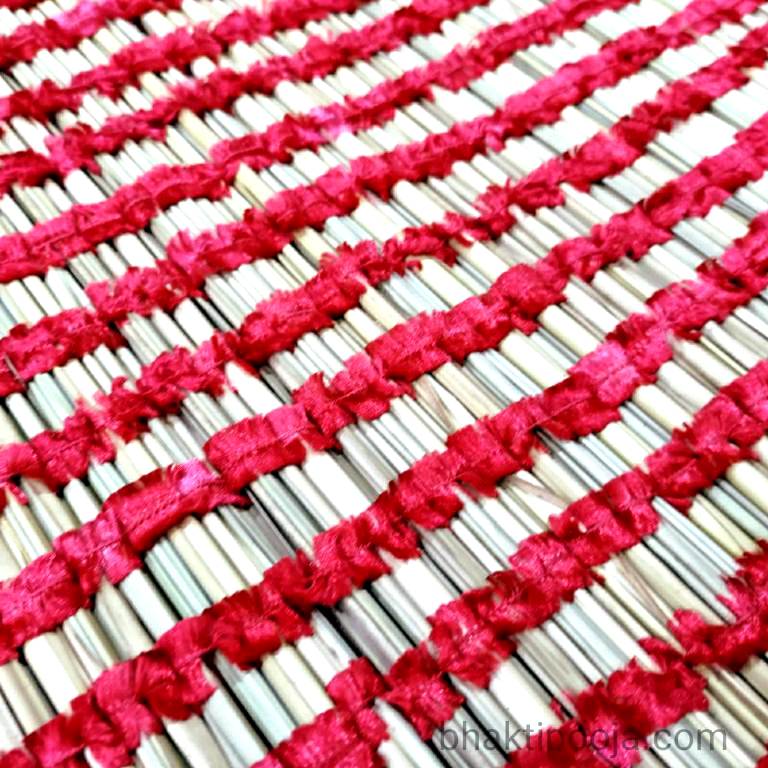- Empty cart.
- Continue Shopping
Pure Kusha Aasan ( Kusha Seating Mat )
₹320.00Current price is: ₹320.00. Original price was: ₹450.00.
The Puranas and Upanishads describe that this grass came into existence after the Churning of the Cosmic Ocean. Legend has it that a few drops of the Amrita (divine nectar) fell onto the grass, giving the grass amazing healing properties.
The Kusha grass aids in meditation and protects the person who sits on it from negative energies. It is so purifying that it is not only used for asans, but it is also used to put keep food from spoiling during an eclipse and to purify the offerings during worship rituals.
During worship and meditation, sitting on kusha grass and chanting powerful mantras will bring clarity to the mind, higher intellect, and purification of dreams.
Darbha/Kusha grass Asan is a must-have as it is cost affordable, purifies the mind and body, and helps to retain the awakened energy in the body as we perform sadhana.
Size : 25 x 25 inches. Kusha Mat with beautiful tread knitting and the stitched border with woolen lase for seating during worship/Meditation
THE BENEFITS OF KUSHA (DARBHA) GRASS
Kusha grass is said to contain the essence of Lord Vishnu. It is what Buddha actually meditated on when He attained enlightenment.
It has immense purifying properties and absorbs radiation in the surrounding environment.
The Puranas and Upanishads describe that this grass came into existence after the Churning of the Cosmic Ocean. Legend has it that a few drops of the Amrita (divine nectar) fell onto the grass, giving the grass amazing healing properties.
The Kusha grass aids in meditation and protects the person who sits on it from negative energies. It is so purifying that it is not only used for asans, but it is also used to put keep food from spoiling during an eclipse and to purify the offerings during worship rituals.
During worship and meditation, sitting on kusha grass and chanting powerful mantras will bring clarity to the mind, higher intellect, and purification of dreams.
Darbha/Kusha grass Asan is a must-have as it is cost affordable, purifies the mind and body, and helps to retain the awakened energy in the body as we perform sadhana.
THE IMPORTANCE OF THE RIGHT ASAN
After we bathe and purify the environment with a ghee lamp (light), dhoop (incense), and tamboura raga (sound), we are now ready to prepare for the puja.
We prepare for the puja by assembling all of the puja offerings (specific offerings will be discussed in a later post) and by ensuring that we have everything we need to comfortably perform the worship.
One thing we need that will greatly enhance the worship is our asan, or seat for religious worship and meditation.
Have you seen pictures of ancient Rishis, Sages, and even Lord Shiva in deep meditation sitting on an asan that is usually some sort of animal skin? Have you ever wondered about the science and reasoning about this?
Essentially, as we perform sadhana the energy is awakened. It becomes active and moves freely in the body. It is important that this energy stays within the body itself and does not get grounded downward into the earth. The asan can help contain the energy in the body.
Below are some guidelines to follow as you design the perfect asan for your worship.
DO NOT SIT ON THE BARE FLOOR
You should never just sit directly on the bare floor while performing spiritual practices.
Sitting on the bare floor dissipates all of your energy, sending it out and about, here and there, and grounding it down into the earth.
Sitting on the bare floor yields the exact opposite results of what we are intending.
We intend to focus the attention and energy internally and move the kundalini (Shakti) upwards, not downwards into the earth.
DO NOT SIT ON METAL CHAIRS
You should never sit on any surface that conducts electricity.
The gravitational force of the earth will react with the surface and move your energy downward.
Metal chairs are the worst culprit for this phenomenon. Chairs made of aluminum, iron, chrome, or any other metal should not be used, nor should leather. Wooden chairs are ok, provided they don’t have leather seating.
MINIMUM ASAN IS CLOTH OR RUG;
DO NOT SHARE YOUR ASAN
At a minimum, the asan should be cotton, wool, silk, velvet cloth, or rug.
It should be used consistently when you meditate, chant, perform Japa, and do puja and homa.
Use it only for the purpose of worship and do not share it with others.
A personal asan gives you the foundation to build your sadhana practice.
It contains your personal energy and your vibration, and it should be kept in a place not assessable to others.
HOW TO SELECT AN ASAN
Follow the scriptures to decide on the best asan for your purposes.
The ancient Vedic texts, the Srimad Bhagavad Gita, the Svetasvatara Upanishad, and the Guru Gita all make mention of the asan.
In general, the state first put Kusha grass (also called Darbha Grass) on the ground, on top of that put an animal skin (sheep, deer, tiger), and then cover it with a soft cloth.
The cloth color can bring additional properties:
red awakens shakti and elevates energy, it helps bring control and discipline
white helps attain moksha, perform sadhana, and creates peace
yellow is for a spiritual seeker with a dedicated practice
orange is for a renunciate and helps in letting go of attachments
THE USAGE OF ANIMAL SKINS
In the ancient days when the Rishi’s lived in the heavily forested ashrams, animal skins were used as asans.
They were taken from animals that died a natural death. Animal skins were more available than cloth back then and provided warmth to them which helped to stimulate energy along the spinal cord.
In our view, it is not necessary to sit on an animal’s skin. But, if you decide to get an animal skin, remember that the skin takes on the vibration of the animal.
The animal should never be killed for obtaining its skin, and it should have died naturally. So proceed with caution if you chose this route.
Kusha Mat with beautiful Knitted threads for seating during worship. A seating mat should be always used while worship and it should be kept separately. It should be cleaned and should not be used by any other person, one should keep their seating mat (pooja aasan) their own. It is just only for clean, spruce, and neatness. When you seat to perform meditation or worship, your entire body is in contact with cosmic energy and if your seating mat (pooja aasan ) would be not neat then you can’t get all benefits of your spiritual journey.
Brand
Sri Kashi Vedic Sansthan























Reviews
There are no reviews yet.